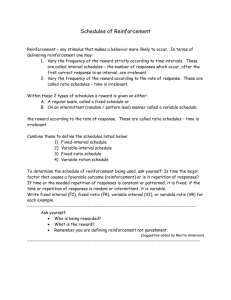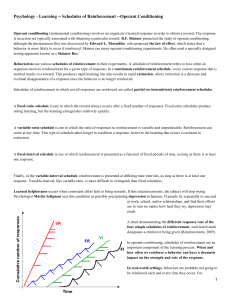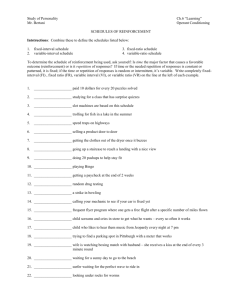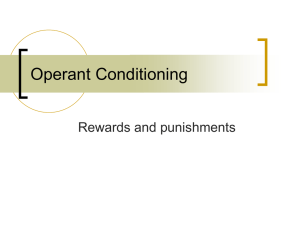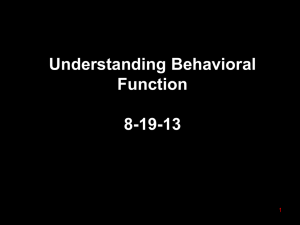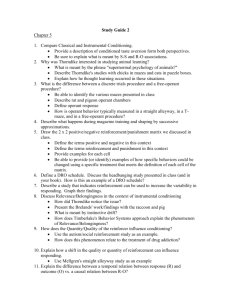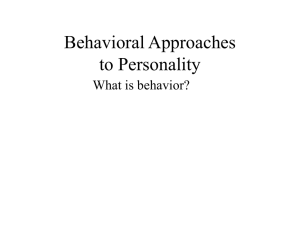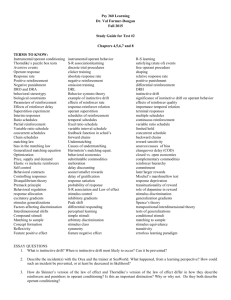Psychology 732 - Association for Behavior Analysis International
advertisement
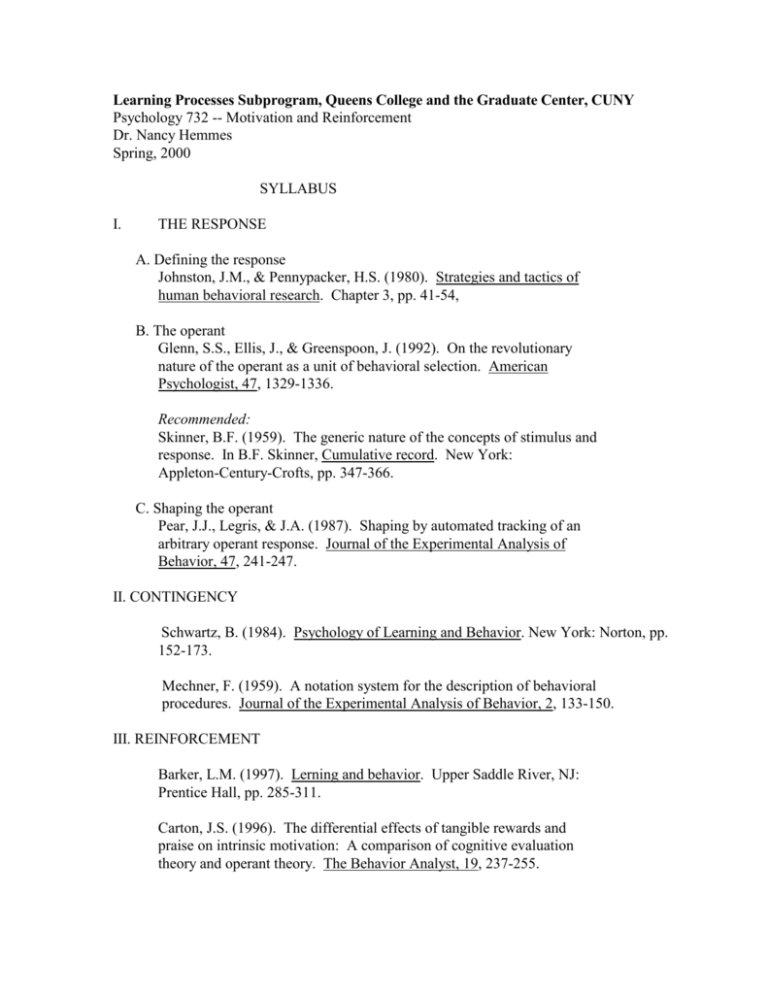
Learning Processes Subprogram, Queens College and the Graduate Center, CUNY Psychology 732 -- Motivation and Reinforcement Dr. Nancy Hemmes Spring, 2000 SYLLABUS I. THE RESPONSE A. Defining the response Johnston, J.M., & Pennypacker, H.S. (1980). Strategies and tactics of human behavioral research. Chapter 3, pp. 41-54, B. The operant Glenn, S.S., Ellis, J., & Greenspoon, J. (1992). On the revolutionary nature of the operant as a unit of behavioral selection. American Psychologist, 47, 1329-1336. Recommended: Skinner, B.F. (1959). The generic nature of the concepts of stimulus and response. In B.F. Skinner, Cumulative record. New York: Appleton-Century-Crofts, pp. 347-366. C. Shaping the operant Pear, J.J., Legris, & J.A. (1987). Shaping by automated tracking of an arbitrary operant response. Journal of the Experimental Analysis of Behavior, 47, 241-247. II. CONTINGENCY Schwartz, B. (1984). Psychology of Learning and Behavior. New York: Norton, pp. 152-173. Mechner, F. (1959). A notation system for the description of behavioral procedures. Journal of the Experimental Analysis of Behavior, 2, 133-150. III. REINFORCEMENT Barker, L.M. (1997). Lerning and behavior. Upper Saddle River, NJ: Prentice Hall, pp. 285-311. Carton, J.S. (1996). The differential effects of tangible rewards and praise on intrinsic motivation: A comparison of cognitive evaluation theory and operant theory. The Behavior Analyst, 19, 237-255. Fisher, W.W., Thompson, R.H., Piazza, C.C., Crosland, K., & Gotjen, D. (1997). On the relative reinforcing effects of choice and differential consequences. Journal of Applied Behavior Analysis, 30, 423-438. IV. MOTIVATION, INCENTIVE, AND ESTABLISHING OPERATIONS Balleine, B.W., Garner, C., Gonzalez, F., & Dickenson, A. (1995). Motivational control of heterogenous instrumental chains. Journal of Experimental Psychology: Animal Behavior Processes, 21, 203-217. Michael, J. (1993). Establishing operations. The Behavior Analyst, 16, 191-206. Poling et al (1990). Free birds aren't fat: Weight gain in captured wild pigeons maintained under laboratory conditions. Journal of the Experimental Analysis of Behavior, 53, 423-424. V. CONDITIONED REINFORCEMENT Lalli, J.S., & Mauro, B.C. (1995). The paradox of preference for unreliable reinforcement: The role of context and conditioned reinforcement. Journal of Applied Behavior Analysis, 28, 389-394. Schaal, D.W., & Branch, M.S. (1990). Responding of pigeons under variable-interval schedules of signaled-delayed reinforcement: Effects of delay-signal duration. Journal of the Experimental Analysis of Behavior, 53, 103-121. Schaal, D.W., Schuh, K.J., & Branch, M.N. (1992). Key pecking of pigeons under variable-interval schedules of briefly signaled delayed reinforcement: Effects of variable-interval value. Journal of the Experimental Analysis of Behavior, 58, 277-286. Williams, B.A. (1997). Conditioned reinforcement dynamics in three-link chained schedules. Journal of the Experimental Analysis of Behavior, 67, 145-159. VI. SCHEDULES OF INTERMITTENT REINFORCEMENT A. Schedule Control and Discriminative properties of Reinforcement Schedules Zeiler, M. (1977). Schedules of reinforcement; The controlling variables. In W.K. Honig, & J.E.R. Staddon (Eds.), Handbook of operant psychology (pp. 201-232. Englewood Cliffs, NJ: Prentice-Hall. B. Delay of Reinforcement Lattal, K.A.. (1984). Signal functions in delayed reinforcement. Journal of the Experimental Analysis of Behavior, 42, 239-253. C. Resistance to extinction D. Concurrent Schedules and Choice Grace, R. C., Schwendiman, J. W., & Nevin, J. A. (1998). Effects of unsignaled delay of reinforcement on preference and resistance to change. Journal of the Experimental Analysis of Behavior, 69, 247-261. COURSE REQUIREMENTS Proportion of Final Grade 10% I. Behavioral Shaping Project Each student will train a rat to emit a 3-response chain. This project must be completed within the first three weeks of the semester. Completion of this project includes demonstrating that your rat executes the chain with little latency between responses, and a written description of your shaping strategy, including the order in which the resonses were trained (justify) and the continuua along which each response was shaped. Also submit a log listing the length of each session and the progress made. 15% II. In-class assignments Written assignments based on assigned readings will be made periodically. In addition, students will be called upon to present material that has been assigned. 50% Midterm and final exams. An essay format will be used. Sample questions will be distributed before each exam. 25% Research report based on an experiment conducted be the class. A full, APA-style manuscript is required.



